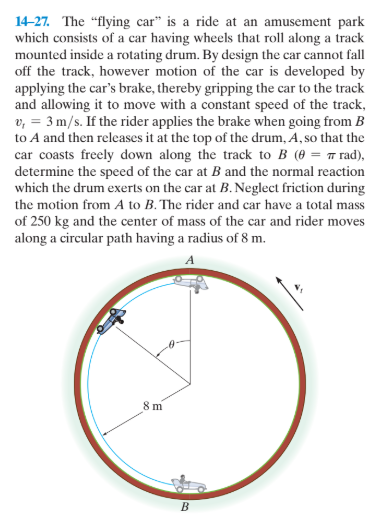14-27. The "flying car" is a ride at an amusement park which consists of a car having wheels that roll along a track mounted inside a rotating drum. By design the car cannot fall off the track, however motion of the car is developed by applying the car's brake, thereby gripping the car to the track and allowing it to move with a constant speed of the track, v, = 3 m/s. If the rider applies the brake when going from B to A and then releases it at the top of the drum, A, so that the car coasts freely down along the track to B (0 = 7 rad), determine the speed of the car at B and the normal reaction which the drum exerts on the car at B. Neglect friction during the motion from A to B. The rider and car have a total mass of 250 kg and the center of mass of the car and rider moves along a circular path having a radius of 8 m. 8 m
14-27. The "flying car" is a ride at an amusement park which consists of a car having wheels that roll along a track mounted inside a rotating drum. By design the car cannot fall off the track, however motion of the car is developed by applying the car's brake, thereby gripping the car to the track and allowing it to move with a constant speed of the track, v, = 3 m/s. If the rider applies the brake when going from B to A and then releases it at the top of the drum, A, so that the car coasts freely down along the track to B (0 = 7 rad), determine the speed of the car at B and the normal reaction which the drum exerts on the car at B. Neglect friction during the motion from A to B. The rider and car have a total mass of 250 kg and the center of mass of the car and rider moves along a circular path having a radius of 8 m. 8 m
Elements Of Electromagnetics
7th Edition
ISBN:9780190698614
Author:Sadiku, Matthew N. O.
Publisher:Sadiku, Matthew N. O.
ChapterMA: Math Assessment
Section: Chapter Questions
Problem 1.1MA
Related questions
Question

Transcribed Image Text:14-27. The "flying car" is a ride at an amusement park
which consists of a car having wheels that roll along a track
mounted inside a rotating drum. By design the car cannot fall
off the track, however motion of the car is developed by
applying the car's brake, thereby gripping the car to the track
and allowing it to move with a constant speed of the track,
v, = 3 m/s. If the rider applies the brake when going from B
to A and then releases it at the top of the drum, A, so that the
car coasts freely down along the track to B (0 = 7 rad),
determine the speed of the car at B and the normal reaction
which the drum exerts on the car at B. Neglect friction during
the motion from A to B. The rider and car have a total mass
of 250 kg and the center of mass of the car and rider moves
along a circular path having a radius of 8 m.
8 m
Expert Solution
This question has been solved!
Explore an expertly crafted, step-by-step solution for a thorough understanding of key concepts.
This is a popular solution!
Trending now
This is a popular solution!
Step by step
Solved in 2 steps with 2 images

Recommended textbooks for you

Elements Of Electromagnetics
Mechanical Engineering
ISBN:
9780190698614
Author:
Sadiku, Matthew N. O.
Publisher:
Oxford University Press

Mechanics of Materials (10th Edition)
Mechanical Engineering
ISBN:
9780134319650
Author:
Russell C. Hibbeler
Publisher:
PEARSON

Thermodynamics: An Engineering Approach
Mechanical Engineering
ISBN:
9781259822674
Author:
Yunus A. Cengel Dr., Michael A. Boles
Publisher:
McGraw-Hill Education

Elements Of Electromagnetics
Mechanical Engineering
ISBN:
9780190698614
Author:
Sadiku, Matthew N. O.
Publisher:
Oxford University Press

Mechanics of Materials (10th Edition)
Mechanical Engineering
ISBN:
9780134319650
Author:
Russell C. Hibbeler
Publisher:
PEARSON

Thermodynamics: An Engineering Approach
Mechanical Engineering
ISBN:
9781259822674
Author:
Yunus A. Cengel Dr., Michael A. Boles
Publisher:
McGraw-Hill Education

Control Systems Engineering
Mechanical Engineering
ISBN:
9781118170519
Author:
Norman S. Nise
Publisher:
WILEY

Mechanics of Materials (MindTap Course List)
Mechanical Engineering
ISBN:
9781337093347
Author:
Barry J. Goodno, James M. Gere
Publisher:
Cengage Learning

Engineering Mechanics: Statics
Mechanical Engineering
ISBN:
9781118807330
Author:
James L. Meriam, L. G. Kraige, J. N. Bolton
Publisher:
WILEY